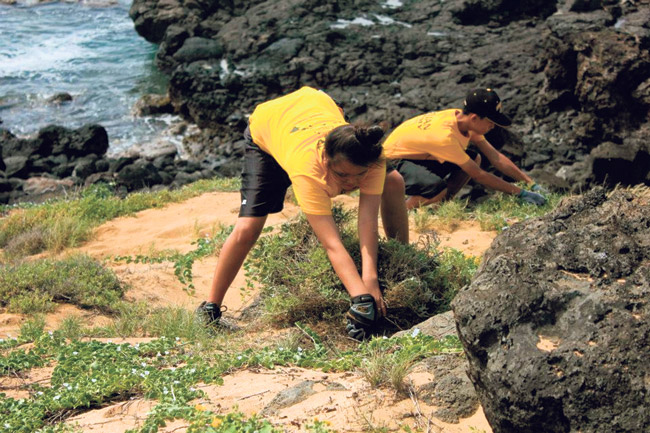Mililani JROTC Cadets Join Ka‘ena Point Protection Work

Cadets Ciera Castro and Dustin Pahk dig deep to remove invasive species at Ka'ena Point. Photo by Cadet Iris Corrales.
CADET IRIS CORRALES
Special to MidWeek Islander
Mililani High School’s Army JROTC Battalion teamed up with Hui Malama, a volunteer service-learning group, on a trip to Ka’ena Point to learn about invasive plants.
While there, the two groups removed the plants in hope of restoring the land and protecting the habitat.
“The purpose of this trip was to motivate students and JROTC cadets to do something meaningful for the community,” explained Cadet Lt. Col. Gi-Hyun Kim, JROTC battalion commander.
Cadet Command Sgt. Major Natasha Parowski added, “Part of our mission is motivating young people to become better citizens, and take what we learn in the classroom and apply it to the community. That is what service learning is about.”
The planning was coordinated by Cadet Lt. Samantha Alvarado and Sandra Webb, a teacher in biological and environmental services. It is the second of three service-learning projects this year in which the cadets will participate.
This is the Army JROTC’s first year at Mililani High School. The program brings not only cadets together, but also the high school’s different departments. Cadet Lt. Andrea Thayne, the battalion’s operations officer, said teaming up with Hui Malama provides many benefits to the cadets.
“Not only was it a way to give back to the community, but also we were able to build a stronger camaraderie among each other.”
The volunteers reached their destination around 8 a.m., and were split into two groups. Group One was driven to the top of the trail to remove salt-bushes and other invasive roots, while Group Two hiked 2.5 miles along the coast to learn about the land as they made their way to meet up with the rest of the volunteers. According to those involved, the trip provided more than the cadets and students could have expected.
“For those cadets who went on this service-learning project, (they) have learned something that we can’t obtain from the textbook – leadership and selfless service,” said Kim.
One of the most important lessons the volunteers learned was how non-native plants negatively affect the natural habitats of the albatross and other species.
“Invasive species are on the rise, and stopping their growth is critical to protecting the native species that are only found here,” said Cadet Corp. Quentin-Tyson Tapaoan.
After a long day’s work, they were able to enjoy the view of Ka’ena Point, located at the western-most tip of Oahu.
“My favorite part of the field trip was having an albatross flying over my head and seeing the Hawaiian monk seal,” said Tapaoan.
The trip also was an example to other students of the importance of giving back, as well as protecting the island’s wildlife.





